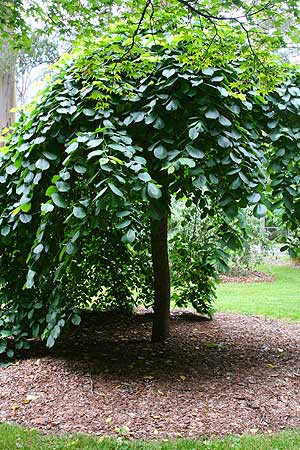
Weeping trees are usually grafted weeping forms of trees such as a weeping cherry trees.
One of the truly classic varieties of weeping trees available for sale, is Ulmus gladra Camperdownii commonly called the ‘Weeping-Elm’ (pictured right).
Many varieties such as dwarf weeping trees, are available for sale online including weeping mulberry tree weeping birch tree or a weeping maple or willow all sold as balled and bur-lapped, or bare rooted plants the during dormant season.
These trees can act as an outstanding feature in any garden. Dwarf weeping trees are popular as are weeping roses trees (bushes).
Weeping trees in a range of forms are most popular in the following states: West Virginia, Ohio, Kentucky, Indiana, Tennessee, Pennsylvania, Idaho, Michigan, North Carolina, Missouri, Rhode Island, Connecticut, Maryland, Utah and New Jersey
Best Weeping Tree Varieties
- Weeping Cherry Trees.
These are grafted and are a fantastic deciduous flowering tree available in a range of forms and colors. Prunus subhirtelia ‘Pendula’ and Prunus serrulata Kiku Shidare Zakura or Cheal’s Weeping Cherry. - Weeping Japanese Maple Trees
Some are grafted and some are not.
Acer esk flamingo has a weeping habit
Acer Japonicum Green Cascade
Acer Palmatum dissectum atropurpureum is a weeping cutleaf maple.
Acer Palmatum dissectum Filigree has a fine lacy foliage. - Cercis canadensis ‘Covey’ – Lavender Twist Redbud
- Cedrus deodara aurea ‘Pendula’
- Weeping Roses
- Weeping Golden Ash
Fraxinus excelsior “Aurea Pendula’ - Weeping Crabapple
Malus ‘Echermeyer’ and Malus ioensis ‘Plena’ - Weeping Birch
Betula pendula ‘Youngii’. This one is usually grafted onto a standard birch. A great feature tree with a graceful weeping habit. - Weeping Mulberry
Morus alba ‘Pendula’ . The white mulberry from China is fairly drought tolerant and is regarded as a hardy tree. - Weeping Apricot
Prunus Mume ‘Pendula’ - Robinia ‘Mop Top’ (Mop Top Robinia)
- European hornbeam
Carpinus betulus ‘Vienna Weeping’ - Weeping Blue Atlas Cedar
Cedrus atlantica ‘Glauca pendula’. This one has drooping branches (hence the ‘pendula’) and is a great specimen tree.
Dwarf weeping trees include a range of ‘Dwarf Japanese Maples’ (grafted). These look great in rockeries.
Varieties of weeping Trees
Weeping trees come into three main categories. Grafted Weeping’ Trees and Trees that have a natural ‘pendulous or weeping habit, we also have dwarf weeping trees that may naturally be a dwarfing variety or again are grafted. Weeping trees may be either deciduous weeping species or evergreen weeping trees,
- Grafted weeping trees are those where the bud from a weeping species is grafted onto the rootstock of an upright species.
- This is usually done so that the weeping habit can be created at a set height, the rootstock chosen to graft to is fast growing and sometimes because the rootstock of the upright tree is stronger. Most dwarf weeping trees are grafted.
- Other weeping trees are those with a natural weeping habit or ‘pendulous’ habit.
Dwarf Weeping Trees
Dwarf weeping trees are increasingly popular with landscapers, weeping mulberry and cherry trees along with dwarf weeping Japanese maple trees all grow well in the garden border as feature plants as well as in containers and pots. Nearly all dwarf weeping trees are grafted, a dwarfing rootstock may be used in many cases.
Dwarf weeping trees are grown by grafting naturally pendulous growing species onto new rootstock, some naturally occurring dwarf weeping trees do exist, however grafted forms are far more common.
People who liked this article also liked:
- Japanese Garden Plants
- Flowering Trees
- Dwarf Weeping Cherry Trees

